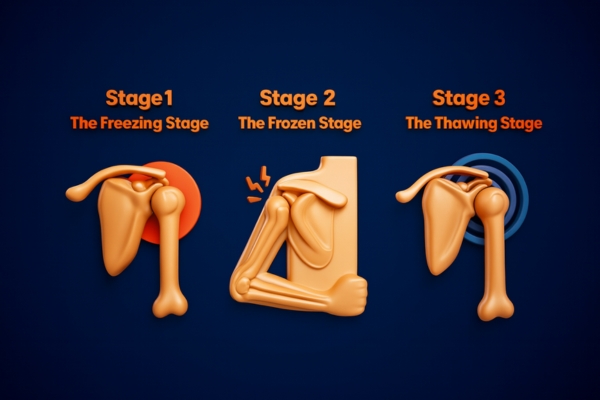Have you noticed your shoulder getting stiff and sore, almost like it doesn’t want to move anymore? Simple tasks like reaching for a plate in the cupboard, putting on a jacket, or even lying on your side at night suddenly feel much harder. For many people between the ages of 40 and 60, this isn’t just normal aging it could be frozen shoulder.
Frozen shoulder, also called adhesive capsulitis, is a condition that causes shoulder pain and stiffness for a long period of time. It tends to affect women more often than men and is more common in people with health conditions such as diabetes or thyroid disorders. Sometimes it appears after surgery or an injury when the shoulder has been kept still for too long.
The encouraging news is that physio treatment for frozen shoulder can help at every stage. A qualified shoulder physio knows how to manage pain, guide safe movement, and gradually restore mobility. To understand how physiotherapy works, it’s important to first know about the three phases of frozen shoulder.
Understanding Frozen Shoulder in Seniors
The shoulder joint is built to move freely, but when someone develops frozen shoulder the capsule that surrounds the joint thickens and becomes tight. This limits how far the arm can move and leads to both pain and stiffness. Unlike a pulled muscle that usually improves within days or weeks, frozen shoulder develops slowly and can last for months or even years if it isn’t treated.
For many seniors, frozen shoulder shows up after a period of immobility, such as following surgery or an injury where the arm was kept still. It can also be linked to certain medical conditions, including diabetes and thyroid disorders, which make people more prone to it. Women between the ages of 40 and 60 are affected more often than men, and once it begins, everyday tasks like dressing, cooking, or reaching overhead become much harder.
This is why working with a shoulder physio early can make such a difference. By keeping the joint as mobile as possible and guiding safe, practical movements, physiotherapy helps slow the stiffness and gives patients tools to manage their pain.
The 3 Phases of Frozen Shoulder

Phase 1: The Freezing Stage
This is the first stage and usually the most painful. It can last from a few weeks up to 9 months. People often describe constant aching in the shoulder, which becomes worse at night and interrupts sleep.
Movement gets more restricted as the capsule tightens. Reaching overhead, fastening a bra, or stretching the arm behind the back feels uncomfortable or impossible.
During this stage, physio for frozen shoulder focuses mainly on pain relief and gentle mobility. A shoulder physio may:
- Teach you ways to move without making pain worse
- Suggest gentle stretches that reduce stiffness
- Show you how to support the shoulder at night for better sleep
- Use hands-on techniques to calm irritation
Even though the shoulder is sore, staying as active as possible is important. A physiotherapist can guide you on safe ways to keep the joint moving without aggravating pain.
Phase 2: The Frozen Stage
This stage can last 4 to 12 months. The good news is that pain often reduces compared to the freezing stage, but stiffness becomes the main problem.
The shoulder feels locked, and lifting the arm or rotating it outward is very restricted. For many seniors, this stage is frustrating because it impacts daily independence.
Here is where How Physio Helps with frozen shoulder becomes very clear. In the frozen stage, a physiotherapist may:
- Use gentle manual therapy to stretch the capsule
- Guide you through specific movements to improve shoulder function
- Introduce a progressive home program tailored to your daily needs
- Encourage functional activities like reaching, dressing, or lifting light objects safely
Attending regular sessions with a shoulder physio near me during this stage can help prevent long-term stiffness and disability.
Phase 3: The Thawing Stage
This stage can last from 6 months to 2 years. Pain gradually decreases, and the shoulder starts to regain movement. Some people regain almost full function, while others may have some minor limitations.
During this phase, physio treatment for frozen shoulder is especially effective. The physiotherapist will progress exercises to rebuild strength, coordination, and flexibility. You may work on:
- Strengthening the muscles around the shoulder and upper back
- Functional tasks like reaching overhead or behind the back
- Practical training for activities like driving, carrying groceries, or gardening
With consistent physiotherapy and home practice, most patients recover well in this stage.
Frozen Shoulder Symptoms
The signs of frozen shoulder build gradually. Here are common Frozen shoulder symptoms:
- Ongoing pain in the shoulder joint
- Pain that is worse at night, especially when lying on the affected side
- Stiffness that restricts everyday movements
- Difficulty reaching overhead, behind the back, or across the body
- Reduced ability to perform tasks like dressing or lifting objects
If these symptoms continue for more than a few weeks, it’s time to see a shoulder physio for a proper assessment.
Risk Factors for Frozen Shoulder
You may be at greater risk if you:
- Are between 40 and 60 years of age
- Are female
- Have diabetes, thyroid disorders, or cardiovascular disease
- Have had recent shoulder surgery or an injury that led to immobility
- Have other health conditions such as low BMI or neck-related issues
Recognising these risks means you can take preventive steps, such as early movement after surgery and booking with a physiotherapist before the stiffness worsens.
How Physio Treatment for Frozen Shoulder Works

Physiotherapy is considered the first-choice treatment for frozen shoulder. While injections and surgery are sometimes used, most patients recover well with conservative care.
A physiotherapist will design a plan based on your stage of frozen shoulder and your lifestyle. Treatment may include:
- Freezing stage: Pain management, posture education, and gentle range-of-motion techniques
- Frozen stage: Joint mobilisation, stretching, and home exercises to restore function
- Thawing stage: Strength and mobility programs to regain normal shoulder use
At Go Run Go Physio, the approach is personal and supportive. Patients receive both hands-on care in the clinic and practical advice for home management. This balance speeds up progress and helps seniors feel more confident in recovery.
5 Frozen Shoulder Exercises
A physiotherapist may suggest simple movements to improve flexibility and reduce stiffness. Here are 5 frozen shoulder exercises often used in treatment:
- Pendulum swing – Lean forward and let your arm swing gently in small circles.
- Finger walk up the wall – Face a wall and walk your fingers upward to improve range.
- Crossover arm stretch – Pull one arm gently across your chest.
- Towel stretch – Hold a towel behind your back and gently pull for rotation.
- Outward rotation with a band – Use a light band to strengthen external rotation.
Your shoulder physio will teach you the correct technique, timing, and progression. Forcing these movements can make the condition worse, so guidance is essential.
When to Seek Extra Help
While many people recover with physiotherapy alone, additional options may be needed in some cases:
- Corticosteroid injections can reduce pain and improve movement early in the condition.
- Hydrodilatation involves injecting fluid into the joint to stretch the capsule.
- Surgery is rarely required but may be considered if symptoms last beyond 2 to 3 years without improvement.
Your physiotherapist can refer you to the right specialist if these treatments become necessary.
Self-Care Tips for Frozen Shoulder
Along with physio for frozen shoulder, you can support recovery with simple steps at home:
- Use heat before stretching to relax the joint, and ice if pain increases.
- Keep moving within a comfortable range instead of resting completely.
- Place a pillow behind or under the arm at night to reduce pain while sleeping.
- Stay active with walking or gentle daily tasks to keep circulation flowing.
- Manage health conditions like diabetes, which can slow healing.
These strategies, combined with professional physiotherapy, create the best recovery outcomes.
FAQs
Q1. How long does frozen shoulder last?
Answer: Without treatment, frozen shoulder can last 1 to 3 years. With physio treatment for frozen shoulder, recovery is often faster.
Q2. Can frozen shoulder heal without physio?
Answer: It may improve eventually, but progress is slow. Physiotherapy speeds recovery and reduces the risk of long-term stiffness.
Q3. Is physio painful for frozen shoulder?
Answer: A good shoulder physio works within your comfort zone. Some stretches may feel tight, but sharp pain is avoided.
Q4. What are the best exercises for frozen shoulder?
Answer: Common movements include pendulum swings, finger walks, and towel stretches. The 5 frozen shoulder exercises described earlier are often used in treatment programs.
Q5. Can frozen shoulder come back?
Answer: It usually affects one shoulder at a time, but in some cases, the other shoulder may develop similar problems later.
Q6. How do I choose the right physio near me?
Answer: Look for experienced physiotherapists who regularly treat shoulder conditions. Searching for a trusted shoulder physio near me can connect you with clinics like Go Run Go Physio, where specialists guide you safely through recovery.
Conclusion
Living with frozen shoulder can feel frustrating, but the condition is treatable. Understanding the three phases helps you know what to expect, and early physio treatment for frozen shoulder makes each stage easier to manage.
With the right care, you can reduce pain, improve movement, and return to everyday activities with confidence. If your shoulder is stiff or sore and you’re searching for help, booking an appointment with Go Run Go Physio is a simple step toward recovery and a more comfortable life.

